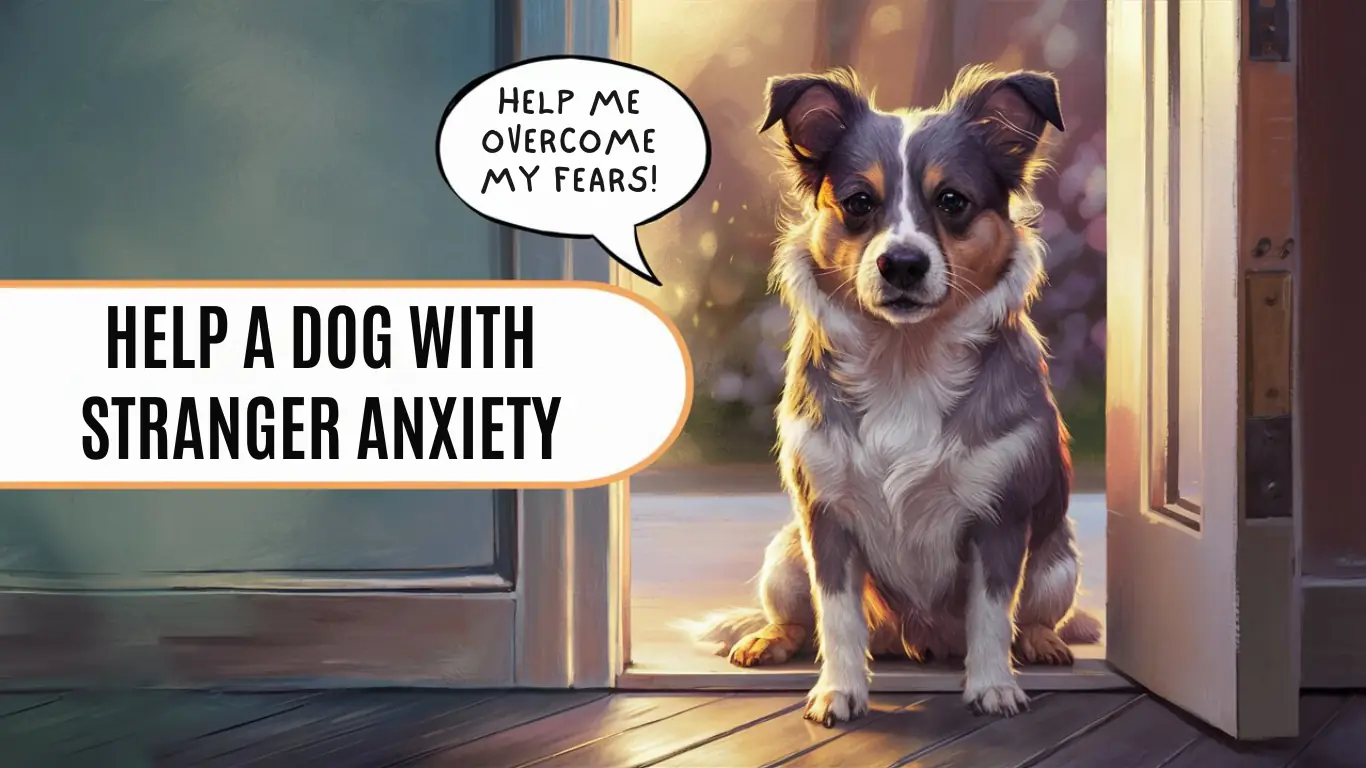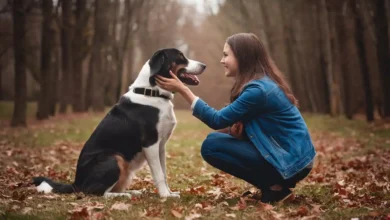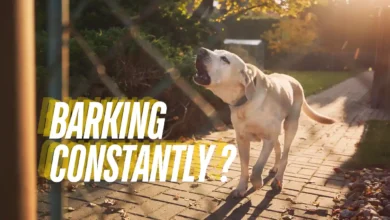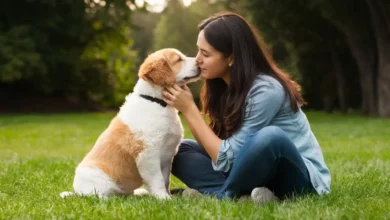How Can I Help My Dog With Stranger Anxiety?

Research shows that stranger anxiety can stem from a dog’s early life experiences. Puppies not exposed to a wide variety of people, sounds, and environments between 3 to 14 weeks of age may develop apprehensions about the unfamiliar later in life.
You might be having the time of your life with your four-legged friend when suddenly, a knock at the door sends your companion into a frenzy of barks and whimpers. It’s not an unusual scenario for dog owners whose pets experience stranger anxiety. This blog isn’t just about tips and tricks; it’s about understanding the roots of stranger anxiety in dogs and forging a path to confidence and calmness, one step at a time.
For further insights into raising a friendly puppy, be sure to check out our companion another article about first time dog owner’s guide.
Early and Consistent Socialization
The first step to remove the stranger anxiety from your pet is to allow them to meet others at a very small age. When pets are used to people from an early age it helps in minimizing the stranger’s anxiety and they won’t bark each time there’s someone at the door.
Start With Puppy Socialization Classes
Puppy socialization classes are considered the gold standard for introducing your puppy to new experiences in a controlled and safe environment. These classes allow your puppy to meet new people, and dogs, and navigate different environments, facilitating their development into well-adjusted, confident adult dogs through positive interactions.
Diverse Experiences Help A Lot
Exposing your dog to a variety of people, settings, and situations regularly is crucial for their development. Diversity in experiences helps cultivate a well-rounded dog, enhancing their adaptability, reducing fearfulness, and promoting a confident demeanor in unfamiliar situations. This broad exposure supports their social and emotional growth.
Creating Positive Associations
Ask your friends to casually toss any treat to your dog when they come to your place. They can also go and pet them so the dog feels less anxious and more at home with the person. The people who are close to you must also learn how to love your dogs and have it back.
Gradual Introduction
A gradual introduction strategy involves having new people initially ignore the dog, giving your pet the freedom to approach in their own time. This technique reduces the pressure on the dog, allowing them to control the pace and nature of the interaction. It respects your dog’s comfort zone and autonomy, making the process of meeting new people less stressful and more positive.
The Power of Treats
Utilizing high-value treats can significantly aid in associating strangers with positive experiences for your dog. Encouraging visitors to gently toss treats to your dog helps in creating an enjoyable link with new people, positioning each stranger as a bearer of good things. This method leverages positive reinforcement to foster trust and curiosity towards newcomers, enhancing your dog’s social skills.
Safe Spaces and Respectful Boundaries

Where do you go when you are feeling tired? For most people, it might be their bed but for others, there is a specific place in the home where they go to just relax and ease their minds. This is what your dog needs as well. So what if they can’t ask for it themselves, they have as many emotions as any human and they deserve to have a safe space.
A Haven at Home
Creating a haven at home for your dog involves setting aside a special spot where they can retreat and feel safe when overwhelmed. This could be a cozy crate or a quiet, secluded room, outfitted with their favorite toys, a comfortable bed, and perhaps an item with your scent for added comfort. This personal space allows your dog to decompress and relax away from the hustle and bustle of daily life, providing a sense of security and belonging.
Recognizing Signs of Stress
Understanding your dog’s body language is key to recognizing when they are feeling stressed or anxious. Common signs include:
- Yawning
- Lip licking
- Hiding
- Seeking solitude
By paying attention to these cues and responding appropriately, you show empathy and respect for their feelings, which strengthens the trust between you. Learning to read these signs enables you to support your dog better and create a safer, more understanding environment for them.
A dog’s past experiences, especially if they’ve had negative encounters with strangers, can significantly influence their behavior. Understanding this is crucial in addressing the root cause of their anxiety.
Incorporating Professional Help
If you think you are unable to help your dog with this anxiety and you have tried all the methods you should try and get professional help. Anxiety is no joke and it should not be taken lightly.
Behavioral Training
A certified dog behaviorist provides personalized strategies tailored to your dog’s unique personality and challenges. They offer professional support in addressing behavioral issues, including anxiety, aggression, or fearfulness. Utilizing positive reinforcement techniques and behavior modification plans, behaviorists can significantly improve your dog’s quality of life. Their expertise not only helps in managing current issues but also in preventing potential future problems, ensuring a happier, more balanced relationship between you and your dog.
Regular Checkups
Regular veterinary checkups are crucial for maintaining your dog’s health and well-being. These visits can uncover hidden health issues that may be contributing to anxiety or behavioral changes. By diagnosing and treating any underlying medical conditions early, you can alleviate discomfort and potentially reduce stress-related behaviors. Consistent checkups ensure your dog remains healthy, and any concerns are addressed promptly, supporting their overall physical and emotional health.
Daily Practices and Longterm Commitments
Little by little one walks far. This is true when you ae trying to get your dog out of this anxiety-ridden phase. All you have to do is take baby steps with them and go from there. But remember that you have to be consistent so that their body starts to adjust to these strangers and reduce the anxiety.
Routine and Predictability
Establishing a daily routine for your puppy can significantly enhance their sense of security and well-being. Consistency in their daily schedule, including set times for walks, meals, playtime, and relaxation, helps them understand what to expect next, reducing anxiety and stress.
This predictability supports their mental health by providing a structured environment where they can thrive. Regular walks not only cater to their physical health needs but also offer opportunities for bonding and training.
Playtime stimulates their mind and strengthens their emotional connection, while relaxation time teaches them to wind down and rest. By maintaining a consistent routine, you’re creating a foundation of trust and safety, making it easier for your puppy to adjust to life with you and feel secure in their home environment.
Patience and Perseverance
Cultivating a bond with your puppy requires patience and perseverance, recognizing that every small step forward is a victory. It’s essential to approach training and socialization with a calm and positive demeanor, as puppies are highly sensitive to their owners’ emotions and reactions. Understanding that setbacks are part of the learning process allows you to maintain a supportive and nurturing environment for your puppy.
Celebrating the small victories, like a successful command execution or a positive social interaction, reinforces desired behaviors and encourages continued progress. Patience in teaching and guiding your puppy, combined with the perseverance to keep moving forward, even when challenges arise, sets the stage for a deep, lasting emotional connection. Your unwavering support and positive reinforcement help build a confident, well-adjusted dog.
The Power of Empathy and Understanding
At the core of these strategies is the bond between you and your dog. By empathizing with their fears and taking proactive steps, you’re not just addressing stranger anxiety; you’re enhancing the quality of your dog’s life. Remember:
- Dogs are highly sensitive to our emotions; your confidence can inspire theirs
- Every dog is unique try to find the approach that fits yours perfectly
- Progress takes time. Celebrate the small moments of bravery and trust
A Future For Your Dog With New Friends
Imagine a future where your dog greets strangers with curiosity rather than fear. This vision is achievable with dedication, understanding, and love. By setting off on this journey together, you’re opening the door to a world where your dog feels safe, confident, and ready to explore the beauty of human friendships. Here’s to a future filled with tail wags, gentle sniffs, and happy, confident dogs.




